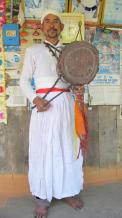EE00002053
 Pawo/Jhakri: Hindhu Shaman
Pawo/Jhakri: Hindhu Shaman
Jhakri, or Dhami, is a local name for the person who performs traditional rituals to cure patients. Since ancient times, people have used these therapies to treat patients through a ritual known as Chhimta, Jhakri.
The history of how Jhakri came to be is related to the story of Lord Shiva and Parvati, his wife. The Goddess Parvati took birth on earth as the daughter of King Himavat and Queen Mena. Narad Muni, a storyteller who carries news and enlightening wisdom, came to look at the baby. She declared she is destined to marry Shiva. While growing up, she would lose herself thinking about Lord Shiva. So when Parvati was of marriageable age, she went to the Himalayas to perform penance and appease Lord Shiva and marry him. Lord Shiva was impressed by her devotion and knew about her desire, and he married her.
After living together for years, one day Lord Shiva was seriously ill and couldn't be cured for so long. Gradually Lord Shiva came to know that the main cause was because of Parvati. She was believed to be overtaken by witchcraft (Sondray in Dzongkha and Bogshi in Lhotshamkha). Lord Shiva shared his concern with his in-laws. His in-laws conveyed the idea that removing the witchcraft will cleanse her soul/mind. Yet they did not know how to resolve the witchcraft. Over time, Lord Shiva and his in-laws tried an idea to cease the witchcraft of Parvati. One day Parvati was distracted stirring over something and not paying attention. Suddenly, Shiva's in-laws jumped in front of her and shouted, "PHAAT!!!" Perceptibly, she was horrified by the sound, and her witchcraft dissipated. So, it is said that the evolution of Jhakri started from that moment. This story was shared by most of the interviewed community members.
Moreover, more stories build on this origin, such as one shared by Mr. Singh Bir Pradhan, a senior citizen of Dzomling Chiwog. Once there came a person called Jangali (another name for Jhakri) to meet Lord Shiva, who had been seriously ill for so long. So Jangali sat to the right of Lord Shiva, and Parvati sat to the left. Jangali came with some tiger grass (botanical name: Thysanolaena latifolia) to treat Shiva using the leaves. The treatment began like a magic show: Jangali swallowed a leaf in his mouth and then pulled it from his bottom. Then he asked Parvati to swallow the tiger grass leaf. As she swallowed the leaf, it stuck halfway down her throat, and she was finding it difficult to swallow completely. Jangali asked her to cough out the leaf with full force. When Parvati coughed fully, the leaf came out, and along with it was the witch. As a result, the leaf left a mark on Parvati’s teeth. So this is another story of the evolution of Jhakri.
Becoming a Jhakri is not like a profession a person can learn or endure. Rather, it's Lord Shiva's prophecy that decides who has the virtue to treat people whenever they are sick. When a person who is destined to be a Jhakri is born, they carry the wisdom of Jhakri and usually suffer from various illnesses at a young age. Their symptoms include frequent stomachaches, headaches, dizziness, back pain, and shivering that cannot be controlled. In a few cases, the person destined to be a Jhakri even has hallucinations. They will not know the causes, yet the illness continues for three to four years. According to Mr. Manbir Khadal, himself a 65-year-old Jhakri, if a person is destined to be a Jhakri, he behaves very strangely even in the mother’s womb. He also added that his own mother had experienced extensive fetal movement and unusual shivering from the time he was a premature baby.
The divination power of a Jhakri will be only born to the person who stays clean, mentally pure, and physically healthy. It sometimes can be related to a person reincarnated as a great lama or Truelku in Buddhism since Jhakri will also be able to predict the past life of a person. Mr. Manbir Khadal also says that with time Jhakri are rarely born. “The current Jhakris are all born before 1990. Some of them already immigrated to other countries after the 1990s problem in southern Bhutan”.
Locals shared the importance of having Jhakri/Dhami in their locality; sometimes someone is sick for a long duration, or they seek out a Jhakri when other forms of treatment like hospital medicine does not cure them. So, the practice of the Jhakri ritual remains strong, and its practices endure through the people across the country. Deo Maya, the wife of Dhami Manbir Khadal, says that a person might suffer from dizziness and back pain if they are aggrievated by the local deities/divinity. If an illness is caused by the evil spirits, patients immediately come to visit her husband to do the ritual.
Mr. Manbir Khadal had been living in his current village, lower Dzomling, for his entire life—and his parents did too. After he was recognized as a Jhakri, he treated countless patients from different parts of our country. From this we can conclude that the people balance their beliefs in both medical science and spiritual therapy. He said, “A few weeks ago, a quadriplegic girl, paralyzed from the waist down, came with her family to do the Jhakri ritual at my house. When she was coming down towards my house, her guardian was carrying her on his back. After doing the Jhakri ritual, she was alright and able to walk without support.” This shows how people believe in the traditional healing therapy practice in this modern world.
Bhutan



